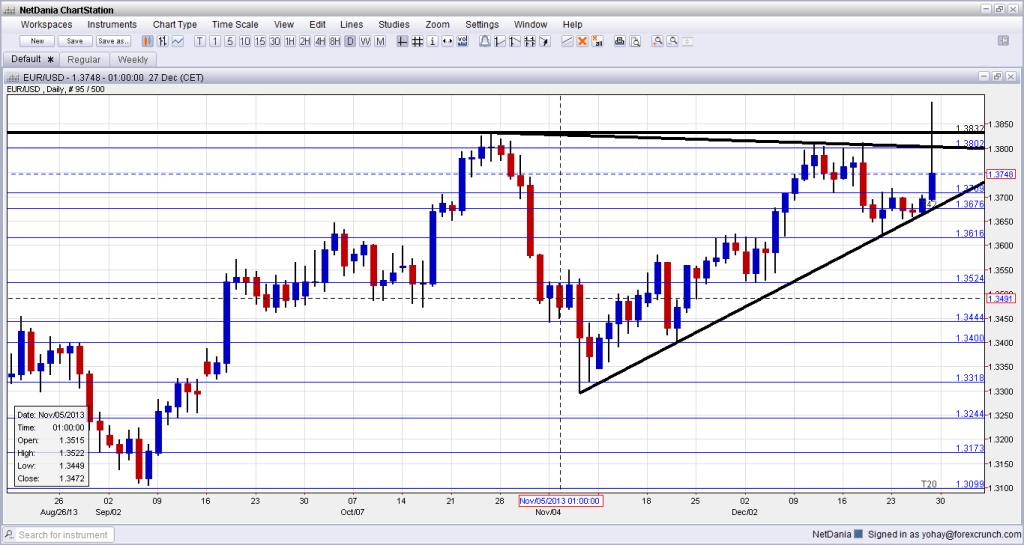EUR/USD enjoyed the low liquidity to shoot higher, but this was short lived. Retail and manufacturing PMI’s, Spanish Unemployment Change and M3 Money Supply are the main market movers this week. Here is an outlook on the major events at the year’s end and the beginning of 2014 and an updated technical analysis for EUR/USD.
Last week, French Consumer Spending edged up 1.4% in November, beating predictions for a 0.3% rise the first gain in : The markets are not used to seeing strong numbers out of France, so Tuesday’s data was unexpected good news. Also the US experienced positive data, before and after Christmas, seemingly justifying the decision of the Fed to taper before Christmas. Can the turn of the year bring more excitement? Let’s start,
[do action=”autoupdate” tag=”EURUSDUpdate”/]EUR/USD daily chart with support and resistance lines on it. Click to enlarge:
- Retail PMI: Monday, 9:10. Eurozone retail sales continued its downturn in sales in November rising slightly to 48 from 47.7 in October. Germany continued its growth trend, yet weaker than the growth rate in the first half of 2013. Italy remained weak, while French retail sales improved marginally. PMI edged up for the first time in August but returned to contraction ever since.
- Manufacturing PMIs: Thursday. Rising demand for manufactured goods pushed euro zone factory activity to speed up its pace in November, reaching a two year record of 51.6 following 51.3 in the previous month. However renewed downturn in France and Spain continued to disappoint. Spanish manufacturing sector sank below the 50 point line to 48.6 contrary to predictions for a rise to 51.3. Meanwhile Italian Manufacturing surprised with a rise to a 30-month high of 51.4 following 50.7 in October indicating industrial expansion. Spanish Manufacturing sector is expected to climb to 49.9, Italian manufacturing is expected to improve further to 51.8 and in the Eurozone the reading is expected to remain unchanged.
- Spanish Unemployment Change: Friday, 8:00. Spanish job market registered the first drop in the number of people registered as unemployed in November due to new openings in construction and industry. The 2,500 decline followed an 87,000 increase in October, contrary to analysts’ projections of a 49.3 rise in the number of unemployed. However, Spain is still suffering from high unemployment, with around 4.8 million people out of work, reaching 26 % of its total workforce.
- M3 Money Supply: Friday, 9:00. The euro zone’s M3 money supply rose less than projected in October, amid a continued drop in private loans. Money supply rose 1.4% below the 1.8% rise predicted by analysts and a 2.0% increase in the previous month. A rise of 1.5% is expected this time.
- Italian Prelim CPI: Friday, 10:00. Consumer price index in Italy dropped 0.4% in November according to preliminary data, posting the third consecutive decline. The price index increased 0.6% from November 2012, compared to a 0.8% annual increased reported in October. This drop comes amid reflects the rising unemployment and the near recession state of the Italian economy. Austerity measures such as raising the VAT rate to 21% from 20% also weigh on growth and on Italy’s tourist industry. Although core inflation, excluding energy and fresh food prices, remained stable at a 1.2% annual rate, overall, price of goods rose 0.1% from a year earlier, while the price for services rose 1.2%. A gain of 0.3% is forecasted now.
* All times are GMT
EUR/USD Technical Analysis
Euro/dollar started the week with a failed attempt to break above the 1.3710 line (mentioned last week). After a long period o range trading, the pair made a quick move all the way to 1.3894, but this was a false break, and it fell quickly to close at 1.3748.
Technical lines from top to bottom:
1.4036 was a separator back in 2011, and awaits the pair if it breaks above 1.40. 1.3940 was a peak in September 2011, over two years ago, and is just before the round number of 1.40.
1.3832 was the 2013 peak (excluding the post-Christmas break). The failure of the pair to get close to this line for a second time might make it a top for a long time, despite the false break. 1.38 is a round number and also worked as a temporary cap during that period of time and also in October 2013.
1.3710 was the previous 2013 peak, and served as a clear separator. The pair needed a big trigger to break above this line, and when it lost it again, the fall was painful. 1.3675 capped the pair in December and also provided some support back in October.
1.3615 worked as resistance in December, as an upper bound for the range. This is the key line to the downside. It is followed by 1.3525, which was the lower bound during this period and also had the opposite role in early 2013.
1.3440 worked as a clear separator in early November 2013 and is a key line to the upside. The round number of 1.34 worked as resistance several times in 2013, and is strengthening now.
1.3320 worked as a double top in early September and it was crossed only with a Sunday gap. It remains a clear separator of ranges. It is followed by 1.3240, which capped the pair in April and also had a role in August. It worked as support in September.
1.3175 capped the pair during July 2013. 1.3100 is worked as temporary resistance in December 2012 and is becoming more important once again, after capping a recovery attempt in June and then in July and providing support in September.
Uptrend support holds perfectly well
From early November, the pair is trending higher, riding above an uptrend support line that currently provides support above 1.36. This has successfully provided support so far, but it may not hold for a long time. The downtrend black thick line emphasizes the lower high the pair reached: from 1.3830 in October to 1.38 in December, and was respected.
I am neutral on EUR/USD
The second holiday week, now encompassing the new year, could be quieter than the Christmas week. In the longer run, the direction of the pair is lower: despite German opposition, the ECB could certainly ease policy once again, sooner rather than later. Tightening financial conditions could be the trigger. In the US, the good data supports further tapers, after the door has already been opened.
More:
If you are interested a different way of trading currencies, check out the weekly binary options setups, including EUR/USD and more.
Further reading:
- For a broad view of all the week’s major events worldwide, read the USD outlook.
- For the Japanese yen, read the USD/JPY forecast.
- For GBP/USD (cable), look into the British Pound forecast.
- For the Australian dollar (Aussie), check out the AUD to USD forecast.
- USD/CAD (loonie), check out the Canadian dollar forecast
- For the kiwi, see the NZDUSD forecast.

